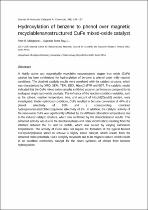 ResearchSpace
ResearchSpace
Hydroxylation of benzene to phenol over magnetic recyclable nanostructured CuFe mixed-oxide catalyst
JavaScript is disabled for your browser. Some features of this site may not work without it.
- ResearchSpace
- →
- Research Publications/Outputs
- →
- Journal Articles
- →
- View Item
| dc.contributor.author |
Makgwane, Peter R

|
|
| dc.contributor.author |
Ray, SS

|
|
| dc.date.accessioned | 2016-06-27T08:43:31Z | |
| dc.date.available | 2016-06-27T08:43:31Z | |
| dc.date.issued | 2015-03 | |
| dc.identifier.citation | Makgwane, P.R. and Ray, S.S. 2015. Hydroxylation of benzene to phenol over magnetic recyclable nanostructured CuFe mixed-oxide catalyst. Journal of Molecular Catalysis A: Chemical, 398, 149-157 | en_US |
| dc.identifier.issn | 1381-1169 | |
| dc.identifier.uri | http://www.sciencedirect.com/science/article/pii/S1381116914005330 | |
| dc.identifier.uri | http://hdl.handle.net/10204/8594 | |
| dc.description | Copyright: 2015 Elsevier. Due to copyright restrictions, the attached PDF file only contains the abstract of the full text item. For access to the full text item, please consult the publisher's website. The definitive version of the work is published in the Journal of Molecular Catalysis A: Chemical, 398, 149-157 | en_US |
| dc.description.abstract | A highly active and magnetically recyclable nanostructured copper–iron oxide (CuFe) catalyst has been synthesized for hydroxylation of benzene to phenol under mild reaction conditions. The obtained catalytic results were correlated with the catalyst structure, which was characterized by XRD, SEM, TEM, EDX, H(sub2-)TPR and BET. The catalytic results indicated that the CuFe mixed oxide samples exhibited superior performance compared to its analogous single nano-oxide catalysts. The influence of the reaction condition variables, such as the solvent, reaction temperature, time, and amount of H(sub2)O(sub2) oxidant, were investigated. Under optimized conditions, CuFe resulted in benzene conversion of 44% at a phenol selectivity of 91% and a corresponding combined hydroquinone/catechol/benzoquinone selectivity of 9%. In addition, the catalytic activity of the nano-oxide CuFe was significantly affected by the different calcination temperatures due to the induced catalyst structure, which was confirmed by the characterization results. This enhanced activity was due to the structural phases and redox modification resulting from the interface between the Cu and Fe metals, which was caused by varying calcination temperatures. The activity of CuFe does not require the formation of the typical favored CuFe(sub2)O(sub4) spinel to achieve a highly active catalyst, which results from the enhanced redox potentials. CuFe is highly recyclable due to its magnetic nature, which results in an excellent ecofriendly catalyst for the direct synthesis of phenol from benzene hydroxylation. | en_US |
| dc.language.iso | en | en_US |
| dc.publisher | Elsevier | en_US |
| dc.relation.ispartofseries | Workflow;16393 | |
| dc.subject | Copper | en_US |
| dc.subject | Iron | en_US |
| dc.subject | Nanostructured | en_US |
| dc.subject | Oxidation | en_US |
| dc.subject | Hydroxylation | en_US |
| dc.subject | Benzene | en_US |
| dc.subject | Phenol | en_US |
| dc.title | Hydroxylation of benzene to phenol over magnetic recyclable nanostructured CuFe mixed-oxide catalyst | en_US |
| dc.type | Article | en_US |
| dc.identifier.apacitation | Makgwane, P. R., & Ray, S. (2015). Hydroxylation of benzene to phenol over magnetic recyclable nanostructured CuFe mixed-oxide catalyst. http://hdl.handle.net/10204/8594 | en_ZA |
| dc.identifier.chicagocitation | Makgwane, Peter R, and SS Ray "Hydroxylation of benzene to phenol over magnetic recyclable nanostructured CuFe mixed-oxide catalyst." (2015) http://hdl.handle.net/10204/8594 | en_ZA |
| dc.identifier.vancouvercitation | Makgwane PR, Ray S. Hydroxylation of benzene to phenol over magnetic recyclable nanostructured CuFe mixed-oxide catalyst. 2015; http://hdl.handle.net/10204/8594. | en_ZA |
| dc.identifier.ris | TY - Article AU - Makgwane, Peter R AU - Ray, SS AB - A highly active and magnetically recyclable nanostructured copper–iron oxide (CuFe) catalyst has been synthesized for hydroxylation of benzene to phenol under mild reaction conditions. The obtained catalytic results were correlated with the catalyst structure, which was characterized by XRD, SEM, TEM, EDX, H(sub2-)TPR and BET. The catalytic results indicated that the CuFe mixed oxide samples exhibited superior performance compared to its analogous single nano-oxide catalysts. The influence of the reaction condition variables, such as the solvent, reaction temperature, time, and amount of H(sub2)O(sub2) oxidant, were investigated. Under optimized conditions, CuFe resulted in benzene conversion of 44% at a phenol selectivity of 91% and a corresponding combined hydroquinone/catechol/benzoquinone selectivity of 9%. In addition, the catalytic activity of the nano-oxide CuFe was significantly affected by the different calcination temperatures due to the induced catalyst structure, which was confirmed by the characterization results. This enhanced activity was due to the structural phases and redox modification resulting from the interface between the Cu and Fe metals, which was caused by varying calcination temperatures. The activity of CuFe does not require the formation of the typical favored CuFe(sub2)O(sub4) spinel to achieve a highly active catalyst, which results from the enhanced redox potentials. CuFe is highly recyclable due to its magnetic nature, which results in an excellent ecofriendly catalyst for the direct synthesis of phenol from benzene hydroxylation. DA - 2015-03 DB - ResearchSpace DP - CSIR KW - Copper KW - Iron KW - Nanostructured KW - Oxidation KW - Hydroxylation KW - Benzene KW - Phenol LK - https://researchspace.csir.co.za PY - 2015 SM - 1381-1169 T1 - Hydroxylation of benzene to phenol over magnetic recyclable nanostructured CuFe mixed-oxide catalyst TI - Hydroxylation of benzene to phenol over magnetic recyclable nanostructured CuFe mixed-oxide catalyst UR - http://hdl.handle.net/10204/8594 ER - | en_ZA |





